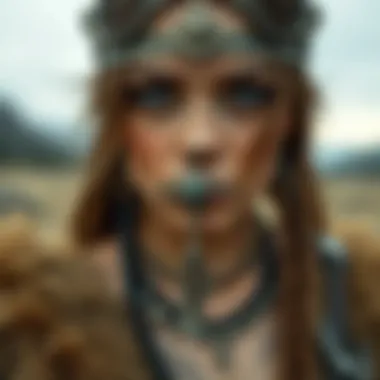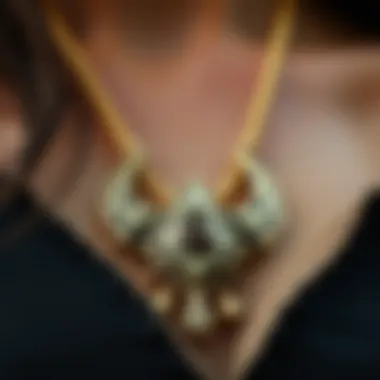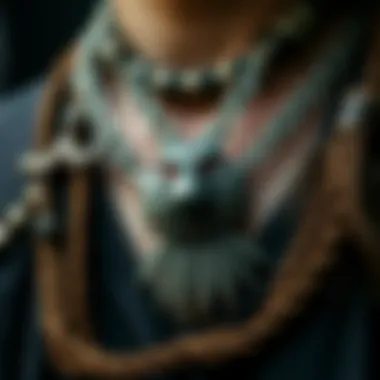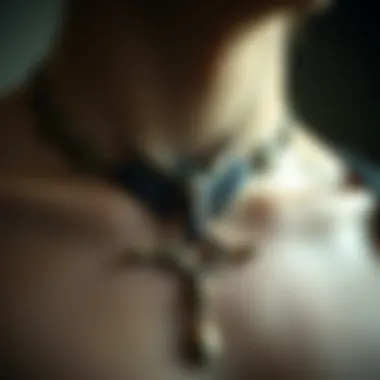Exploring the Rich Heritage of Viking Necklaces


Intro
The Norse Viking necklaces, steeped in history and culture, tell tales that echo through the ages. Made primarily from materials like silver, bronze, and glass beads, these pieces were not mere adornments; they held significance that went beyond mere aesthetics. They showcased a person's status, beliefs, and even protection against evils. These necklaces captured the spirit of a time when craftsmanship and symbolism went hand-in-hand, woven into the very fabric of society.
As you journey through this exploration, you will uncover how these necklaces transformed from practical items for warriors and traders to sought-after fashion statements in today's world. The resurgence of interest in Viking jewelry speaks volumes about our collective desire to connect with the past and draw inspiration for contemporary styles.
The journey does not end with an understanding of their significance. This article will also guide you in sourcing authentic Viking-inspired pieces today, ensuring you have a piece of history that is not only beautiful but also steeped in rich heritage. Wherever you go, whether at markets or specialized stores, understanding their importance will add a layer of appreciation when you adorn yourself with such unique jewelry.
With that set, let’s delve into the Fashion Trends surrounding these remarkable pieces.
Prelude to Norse Viking Necklaces
Norse Viking necklaces hold a significant place in both history and modern culture. These adornments are more than mere pieces of jewelry; they are symbols of social status, artistry, and belief systems that persevere through centuries. Their compelling designs tell the stories of the Vikings’ connection to nature, mythology, and their intricate societal structures. As we delve into the nuances of these necklaces, we see how they reflect an era steeped in richness and depth.
One of the many benefits of understanding Viking necklaces is the appreciation they evoke for craftsmanship. These pieces often showcase a melange of materials like metals and gemstones, each chosen for their symbolism or properties. But, it’s not just about aesthetics; historical context plays a pivotal role in how we interpret these items today. The vestiges of Norse culture draw us in, generating interest among fashion enthusiasts and collectors alike.
Moreover, exploring Viking necklaces leads us to consider broader cultural implications. This jewelry was not only a personal expression but also a means of communicating one’s identity and values within the community. We will examine these defining characteristics closely, shedding light on the historical context that has shaped these stunning artifacts.
Defining Characteristics
Viking necklaces exhibit unique features that distinguish them from other forms of jewelry. Intricate craftsmanship, elaborate designs, and significant materials convey a profound respect for art and tradition. Many necklaces boasted motifs inspired by Norse mythology, often intertwined with nature or celestial patterns. For example, a typical design might include dragon or serpent patterns that signify strength and protection, whereas intricate knot designs often represent eternity and connection.
The materials used also define their characteristics. Many prominent pieces were crafted from durable metals such as silver and bronze, often alloyed with other elements to enhance their appearance and strength. The use of gemstones, such as amber and garnet, added vibrancy and held various meanings in Norse culture. Additionally, organic materials like bone or wood were not uncommon in the creation of certain necklaces, ensuring that they were accessible to a broad range of individuals from rich chieftains to common folk.
Historical Context
The creation of Viking necklaces does not exist in a vacuum. To truly understand them, one must appreciate the historical context in which they were made and utilized. The Viking Age, spanning from the late eighth century to the eleventh century, was marked by exploration, trade, and conquests that spanned Europe and beyond. During these times, jewelry became a signifier of not just personal wealth, but also wisdom and bravery.
Archaeological findings reveal that necklaces were often buried with their owners, suggesting they held profound significance in both life and death. The craftsmanship found in gravesites attests to the skills of the artisans and the deep cultural values tied to the creation of these items. Historians and archaeologists have linked the styles and symbols found in these necklaces to the narratives in Norse sagas, hinting that they were more than just adornments—they served as cultural artifacts imbued with meaning and history.
Understanding these defining traits and the historical backdrop of these necklaces allows us to grasp the full scope of their relevance—both in the past and in the modern world. As we move on to explore the materials used in Viking necklaces, it will become clear that every choice was a step toward telling a larger story.
The Historical Origins of Viking Jewelry
The historical backdrop of Viking jewelry is not just an exploration of aesthetics; it's a journey into the cultural and spiritual fabric of Norse society. These adornments were deeply intertwined with the identity of the Norse people, reflecting their values, beliefs, and social structures. Understanding the origins of these pieces sheds light on how they transformed from simple functional items to symbols of power and status. In this section, we’ll dig into the folklore and tangible evidence that paint a vivid picture of Viking life through their jewelry.
Norse Mythology and Symbolism
Norse mythology is a treasure trove of stories that shaped the lives of the Vikings and their artistic expressions. Jewelry was not merely for decoration; it was a conduit for spiritual beliefs and a reflection of their cosmology. For instance, the Thor's hammer, also known as Mjolnir, was a popular motif in Viking pendant designs. This represented protection and power, symbolizing the might of the thunder god himself.
Moreover, many pieces featured designs inspired by the Yggdrasil, the World Tree connecting different realms. They believed that wearing such symbols could offer blessings or protection from harm. The intricate knots and patterns found in their jewelry hinted at the complex interconnections of their universe, illustrating the cycle of life, death, and rebirth.
A significant aspect of their symbolism revolved around amulets. Often, these amulets were imbued with personal meaning, connecting the wearer to their ancestors or gods. This daring dance between the tangible and the spiritual grabbed the Viking imagination, leading them to craft pieces that reflected their hope and fears.
Archaeological Findings
Archaeological excavations across Scandinavia have unearthed numerous artifacts that validate the significance of jewelry in Viking life. Sites like the Oseberg ship burial in Norway or the Gokstad mound have revealed exquisite necklaces, brooches, and rings, all pointing to a well-developed craftsmanship.
These findings highlight several key materials they utilized:
- Silver and Gold: Predominantly sourced through trade, these metals were favored for their intrinsic value and malleability.
- Garnets and Amber: Commonly found in Viking jewelry, these stones were often imported and were thought to possess healing properties.
- Bone and Wood: Everyday materials that echoed the Vikings' close relationship with nature.
To find out more about the wealth of information these archaeological sites provide, check out resources from Encyclopedia Britannica.


The evidence collected from these archaeological digs paints a multifaceted portrait of Viking culture. Jewelry was not just a marker of wealth; it acted as a critical connection to their past, a bridge between their world and the divine. Understanding these origins enhances our appreciation for the Viking necklaces we see in today's fashion. As contemporary designers draw from these deep wells of history, we can see how the cyclical nature of art and culture continues to play out.
Materials Used in Viking Necklaces
The materials used in Viking necklaces tell a story that goes beyond mere adornment. They reflect the ingenuity of Norse artisans and their connection to the earth, the sea, and the cosmos. Understanding the materials allows us to grasp the cultural significance and the practical considerations that shaped these beautiful pieces. The choices of metals, gemstones, and organic materials in jewelry reveal not only aesthetic preferences but also social status and religious beliefs.
Metals and Alloys
When it comes to Viking necklaces, metals played a pivotal role in their construction. Silver, gold, bronze, and iron were the primary metals utilized, each carrying its own importance. Viking smiths were skilled in metallurgy, often blending and manipulating these metals to produce unique designs.
Silver was the most favored material, primarily due to its beauty and rarity compared to other metals. Many Viking traders exchanged silver from the east, which made it a symbol of wealth and power. Gold, on the other hand, represented divine favor and was often reserved for the elite. A simple gold necklace could delineate a chieftain’s standing in society.
- Bronze was also common, often used for more functional pieces given its sturdiness.
- Even iron, though not as glamorous, found its place in necklaces, particularly in more rugged designs intended for everyday wear or warrior adornments.
Viking artisans often adorned their necklaces with intricate designs made from these metals, such as knotwork and animal motifs, reflecting their reverence for nature and mythology. The alloying of metals, like creating a bronze from copper and tin, showcased their advanced skills. This mastery enabled them to produce pieces that were not only visually appealing but also durable.
Gemstones and Organic Materials
Beyond metals, Viking necklaces often included gemstones and organic materials, which served various significances from adornment to protective qualities. Stones like garnet, amethyst, and even quartz were used, each believed to hold special powers or meanings. For instance, garnets were often thought to offer protection in battle, while amethyst was associated with peace and clarity of mind.
- Amulets made from stone or wood were common, often inscribed or carved with mystical symbols for protection or guidance.
- The use of organic materials was not uncommon either, including materials like bone, ivory, or shells—each bringing its own charm and story to the necklace. These materials also represented the Viking's connection to nature and their ability to use the resources at hand.
"The mix of metals, stones, and organic materials in Viking necklaces is more than craftsmanship; it's a reflection of the Norse people's core beliefs, values, and social structure."
In summary, the materials used in Viking necklaces are a fascinating contemplation of utility and artistry. They highlight the ingenuity of Norse craftsmanship and the rich layers of meaning behind adornments that extend well beyond mere beauty.
Distinctive Designs of Viking Necklaces
The designs of Viking necklaces are not merely decorative; they embody a rich tapestry of culture, belief, and artistry. With their intricate craftsmanship and symbolism, these ornaments serve as a lens through which we can understand the values and identities of the Norse people. In this section, we will delve into several key aspects of Viking necklace designs, including their functional and decorative elements, the use of amulets, and the unique patterns and motifs that characterize this ancient jewelry.
Amulets and Talismans
In the Norse world, amulets and talismans were more than just beautiful adornments; they were believed to hold protective powers and bring good fortune. Vikings often crafted necklaces with specific symbols that represented their gods, mythical creatures, or personal beliefs. For instance, the Thor's Hammer, or Mjölnir, symbolized strength and protection against evil forces. Wearing such a pendant could be a source of comfort and courage for the wearer.
Additionally, these pieces served as a form of identification or affiliation. For example, the Yggdrasil, the Tree of Life, represented interconnectedness of all realms, and its depiction on jewelry signified a deep spiritual belief among Norsemen. The significance of these items went beyond their physical form; they were integral to Norse identity and spirituality, vibrating with life and stories of the past.
Intricate Patterns and Motifs
The decorative element of Viking necklaces is exemplified through various intricate patterns and motifs. Craftsmen used both geometric forms and naturalistic representations drawn from the rich tapestry of Norse mythology. Knotted designs and interlacing patterns abound, depicting important themes such as the eternal cycle of life and death, as well as the bond between individuals and nature.
In many cases, a singular piece of jewelry like a necklace could tell a broader story. For example, necklaces embellished with animal motifs—specifically wolves, eagles, and serpents—were not just decorative; they communicated dominance and ferocity. The sophistication of these designs showcases the artistry and technical skill of Viking goldsmiths and is part of what makes these pieces so compelling today.
Functional vs. Decorative Elements
It's important to recognize that Viking necklaces often blurred the line between functional and decorative elements. While many pieces served as stunning fashion accessories, others had very practical purposes. Clasps, hooks, and pins were meticulously designed not only for beauty but for functionality as well.
Consider how certain necklaces acted as a symbol of status; the larger and more ornate a piece, the more significant the social standing of its wearer. On the flip side, simpler designs were often used for everyday wear among common folk, indicating their status without ostentation. By examining these dynamics, it becomes clear that Viking necklaces encapsulate both artistry and utility, reflecting the social structures of their time.
"In a Viking necklace, we find the elegance of artistry intertwined with the fabric of daily life, a mirror to their culture and beliefs."
Cultural Significance of Necklaces in Norse Society
Necklaces were more than mere adornments in Norse society; they held deep cultural significance that intertwined with notions of identity, status, and spirituality. These pieces of jewelry often served as a reflection of an individual’s place within the social fabric and revealed much about their beliefs and personal allegiances. In this section, we will explore the dual aspects of necklaces: their role in expressing social hierarchies and their importance in ritualistic practices.
Social Status and Identity


In the Viking Age, which spanned roughly from the late 8th century to the early 11th century, necklaces were not just fashion statements but powerful symbols of social status. Wealth was often displayed through intricate designs and the materials used. For instance, a necklace made from silver or gold signified a well-off individual, while more common folk might wear pieces made from cheaper materials, such as copper alloys or glass beads. Some necklaces held specific shapes or symbols that denoted clan affiliations or personal achievements, allowing wearers to communicate their identity without uttering a single word.
"Jewelry was like a badge of honor; it spoke volumes of a person's background and aspirations."
For many Vikings, the act of wearing such jewelry was an important social practice. Men and women adorned themselves not only for beautification but also to align themselves with the gods' favor or their community’s expectations. Individuals wore pieces that portrayed power, courage, or fertility, depending on their life stage or societal role. It was not uncommon to find amulets closely tied to Norse mythology—like Thor's hammer—worn to invoke protection or strength.
Ritualistic Uses
Necklaces additionally played a significant role in religious and ritualistic activities. They were often used in ceremonies intended to honor deities, celebrate life events, or mark rites of passage, such as weddings or funerals. For example, some necklaces were dedicated to Freyja, the goddess of love and fertility, believed to grant blessings to those who wore them.
Furthermore, necklaces served as talismans in rituals designed for protection against misfortune or illness. The special designs and symbols, often personal to the wearer, were thought to hold magical properties. Each piece carried representational power, which could influence the circumstances of daily life. Viking funerals also prominently featured necklaces; placing jewelry with the deceased was believed to provide comfort and status in the afterlife, emphasizing the lifelong importance of these items.
By understanding the social and ritualistic dimensions of Viking necklaces, we gain insight into the complexities of Norse culture. Their dual purpose as a marker of identity and a sacred object highlights the nuanced way in which Vikings engaged with their world, blending the order of society with spiritual beliefs.
In considering how these objects resonate today, one may see echoes of their significance in contemporary jewelry practices, where personal style and symbolism still play critical roles in how we choose to present ourselves. For those treasuring authentic Viking jewelry today, it is vital to remember the meanings that imbued these ancient pieces with profound significance.
The Evolution of Viking Necklaces through Time
The transformation of Viking necklaces reflects a dynamic interplay between practicality and artistry. These adornments have evolved from mere tools of utility to highly sought-after works of art, embodying both cultural heritage and personal identity. Understanding this evolution provides a deeper appreciation for these pieces and guides collectors and enthusiasts in their journeys.
From Utility to Craftsmanship
In the early days of the Viking Age, necklaces were crafted primarily for practical reasons. They served as indicators of status and were often associated with survival; after all, for a sea-faring culture, functionality trumped aesthetics. Made of simple materials like leather or bone, these necklaces were frequently utilitarian. They might hold tools or important symbols, acting as protective charms in a world full of uncertainty.
As time moved on, a noticeable shift took place. The Vikings began incorporating a variety of materials, such as silver and gold, into their jewelry. The raw artistry emerging during this period showcased intricate designs and elaborate craftsmanship. It was no longer just about utility, but also about the beauty that could be achieved through methodical skill.
- Metals and craftsmanship: Skilled artisans would engage in techniques such as filigree work, creating delicate patterns that entwined, echoing the natural forms of the world.
- Symbolism: A necklace wasn't merely a piece of jewelry; it carried stories, tales of gods and legendary heroes, embedded in the very design.
This transition led to the production of amulets and especially talismans that signified protection or good fortune, showcasing how Viking society began to intertwine spirituality with adornment.
Modern Interpretations
Fast forward to today, and you find that Viking necklaces have made quite the comeback in contemporary fashion. A mix of heritage and modern design principles are at the forefront of this renaissance. Designs echo ancient styles yet embrace the sensibilities of the modern world, offering insights into both historical significance and personal taste.
- Fashion trends: Designers are often influenced by the rough yet refined aesthetic of Viking jewelry, incorporating chunky metals, earthy tones, or rustic pendants into their collections. This has made them a favorite among fashion-forward individuals who embrace a raw yet refined approach to their wardrobe.
- Cultural revival: Shows like Vikings have thrust this jewelry into the limelight, making it a staple not just for reenactors but for everyday wear, appealing to enthusiasts of both history and style. This connection cultivates an appreciation for craftsmanship that aligns with personal expression, giving new life to long-forgotten traditions.
In essence, the journey of Viking necklaces mirrors that of society—what began as basic adornments has evolved into symbols of culture and personal identity, bridging the past and present.
"Every time you wear a piece of Viking jewelry, you’re not just wearing metal and stones; you are donning a slice of history, steeped in stories and traditions that have stood the test of time."
By recognizing this evolution—from functional utility to intricate artistry—collectors and enthusiasts can navigate the market for these pieces with a more discerning eye, ensuring that they’re not just acquiring jewelry, but a piece of history.
Contemporary Interest in Viking Necklaces
The allure of Norse Viking necklaces continues to captivate audiences today, transcending the boundaries of time and culture. This interest isn't merely a flash in the pan; it reflects a deep appreciation for craftsmanship and heritage that resonates with many. How these pieces are integrated into contemporary fashion speaks volumes about shifting trends and the enduring human fascination with the past.
Fashion Trends and Influences
In recent years, Viking necklaces have found their way into mainstream fashion. Designers and fashion houses have begun to incorporate these ancient motifs into their collections, paying homage to a rugged aesthetic that speaks to individuality and strength. Jewelry that features intertwined knot patterns, animal symbols, and mythological representations taps into a longing for stories and meaning in what we wear.
- Unique pieces, such as those adorned with Thor's hammer or the Valknut symbol, push the envelope of traditional jewelry while speaking to historical significance.
- More casual businesses have hopped on the bandwagon, creating accessible replicas that stay true to the original designs, appealing to casual wearers and fans alike.
From the red carpet to everyday street styles, the warm embrace of Viking influences is apparent. Influencers showcasing these chunks of history in their outfits have increased interest across various social media platforms. By merging ancient designs with modern fabrics, contemporary fashion is exploring a blend that feels genuine yet novel, providing the wearer with a connection to something greater—like wearing a story.
The Role of TV and Film in Revival


There's no denying that the powerful portrayal of Viking culture in today's television and film has played a huge role in rekindling interest. Productions like Vikings and the How to Train Your Dragon movie series have thrust Norse folklore into the spotlight. The dramatic visuals and complex narratives surrounding Viking life have fostered a sense of curiosity and nostalgia.
"Pop culture phenomena can reignite interest in historical artifacts by presenting them in accessible narratives."
As viewers become enamored with these stories, they often seek to connect deeper with the culture they see on screen. This connection is made tangible through fashion, primarily via Viking necklaces that echo the artistry displayed in these stories. New brands have emerged, capitalizing on the show's iconography by producing jewelry that reflects the aesthetics made famous by the characters and settings. Consequently, consumers are not just purchasing a necklace; they are buying a piece of their favorite tale, merging personal style with a story that has stood the test of time.
Thus, the realms of fashion and entertainment are intertwined more than ever before. Collectively, they shape and amplify the modern fascination with Viking necklaces, ensuring that these ancient artifacts remain symbols of identity, artistry, and cultural continuity.
Collecting and Sourcing Authentic Viking Necklaces
When it comes to collecting Norse Viking necklaces, the hunt for authenticity is crucial. These pieces are not just beautiful adornments; they are tangible links to a rich cultural heritage steeped in myth and history. Understanding how to identify genuine pieces can enrich a collector's journey and also fortify their investment in Viking history.
What to Look for in Authenticity
Authenticity can be a real minefield, but there are specific elements to consider when evaluating a Viking necklace:
- Material Composition: Authentic Viking necklaces are often crafted from metal such as silver or bronze. If a piece looks too shiny or new, that's a red flag. Real vintage pieces might have a more muted, aged patina.
- Craftsmanship: Look closely at the details. Hand-forged items will show irregularities or imperfections, showcasing the artisan's skill. Machine-made replicas tend to have a uniform appearance.
- Historical Context: Familiarize yourself with the motifs commonly used in Viking jewelry, such as dragons and runes, and assess whether these elements reflect the period you are interested in.
- Provenance: A good seller will provide documentation or proof of authenticity. If a necklace once belonged to a museum or a reputable collector, that boosts its credibility.
"A buyer should never rush their purchase; patience can lead to acquiring a true piece of history."
By understanding these key features, one can better navigate this intricate world and avoid the pitfalls of forgeries.
Marketplaces for Collectors
Finding authentic Viking necklaces requires knowing where to look. Here’s a breakdown of some marketplaces that cater specifically to collectors:
- Antique Shops: These often house unique finds. The advantage is the immediacy of handling the piece before purchasing.
- Online Auctions: Platforms like eBay have sections specifically for historical items, though one must verify the seller’s rating and reviews.
- Specialty Jewelry Websites: Websites like Etsy can have one-of-a-kind handmade replicas inspired by Viking designs, and some sellers provide information about their creation process, helping assess authenticity.
- Museums and Exhibitions: Local museums sometimes sell replicas in their gift shops, and visiting exhibitions may reveal contacts of authentic dealers.
- Collectors’ Circles: Joining online forums or communities on Reddit or Facebook can open doors to private sellers with genuine items.
Putting in the time to research and network can significantly enhance both the purchasing experience and the collection itself. In the realm of Norse Viking necklaces, a solid grasp of how to identify authenticity and where to find reputable pieces can make all the difference.
Caring for Viking Necklaces
Caring for Viking necklaces is not just about preserving the aesthetics of these historical artifacts; it's essential for maintaining their cultural significance and the stories they tell. Proper care ensures these pieces can be appreciated for generations to come, allowing their beauty and craftsmanship to shine through. Viking necklaces, often embedded with profound symbolism and intricate designs, deserve attention and respect. Their value isn't only monetary but also historical and emotional.
Cleaning and Maintenance
Cleaning Viking necklaces requires a delicate approach given the diverse materials they are made from, such as metals, gemstones, and organic components. Here are some key steps to ensure they stay in pristine condition:
- Gentle Cleaning: Use a soft, lint-free cloth to gently wipe the surface. For more stubborn grime, a mixture of mild soap and lukewarm water can be used. Avoid harsh chemicals that could damage the integrity of metals or stones.
- Drying: After cleaning, ensure that the necklace is dried thoroughly. Water left on jewelry can lead to tarnishing or mold on organic materials like leather or wood.
- Inspection: Regularly inspect for signs of wear or damage, such as loose stones or weak clasps. This allows for early detection of issues, preventing further damage.
"Just like the tales of old, a Viking necklace tells a story, and it deserves to be told in its finest form."
Storage Tips
Storing Viking necklaces correctly is crucial for preserving their integrity. Here are some practical tips:
- Use a Soft Pouch: To avoid scratches, store necklaces in a soft cloth pouch or an individual compartment in a jewelry box. This minimizes friction with other pieces.
- Avoid Humidity: Store in a dry, cool place to prevent tarnishing from humidity, particularly for metal components. A silica gel packet can help absorb moisture.
- Keep Away from Sunlight: Direct sunlight can fade colorful gemstones or damage organic materials. A dark, stable environment is ideal.
- Organized Display: If displaying them, consider a stand that prevents tangling and movement. It not only looks attractive but also makes them easily accessible for wearing.
By taking these steps to clean and maintain Viking necklaces, collectors and enthusiasts alike can ensure that these enchanting pieces continue to spark curiosity and admiration for years to come.
The End
The examination of Norse Viking necklaces reveals not just objects of beauty, but also threads interwoven with history, culture, and identity. As previously discussed, these adornments did not simply serve aesthetic purposes; they were deep symbols steeped in the rich narrative of the Viking world. The intricate designs often reflected societal roles, mythological tales, and personal beliefs. As we dissect their evolution, we see a transition from utilitarian pieces to revered artifacts of craftsmanship in modern interpretations.
The Legacy of Viking Necklaces
Viking necklaces hold a distinct place in the fabric of Norse civilization. They weren't just accessories but were often markers of social status and identity, allowing wearers to showcase their alliances and personal achievements. Keep in mind how these pieces were often fashioned with materials that resonated with the wearer’s standing—gold and silver for the wealthy, while others might opt for simpler elements.
"Necklaces reflected the world of Norse gods, warriors, and everyday life, bridging the past with the present."
Cultural Relevance Today
In an era where ancient motifs are finding their way into modern fashion, the resurgence of interest in Viking necklaces speaks to a longing for connection with our roots. Fashion enthusiasts and casual shoppers alike are drawn to the symbolism behind these pieces. Whether it be for a statement look or a connection to heritage, these necklaces carry weight in a world often craving authenticity.
Practical Considerations for Collectors and Wearers
When considering investing in or wearing Viking replicas, the importance of understanding authenticity cannot be overstressed. Asking the right questions and being aware of reputable marketplaces is essential. This helps maintain the narratives these pieces hold and the appreciation for their origins.







